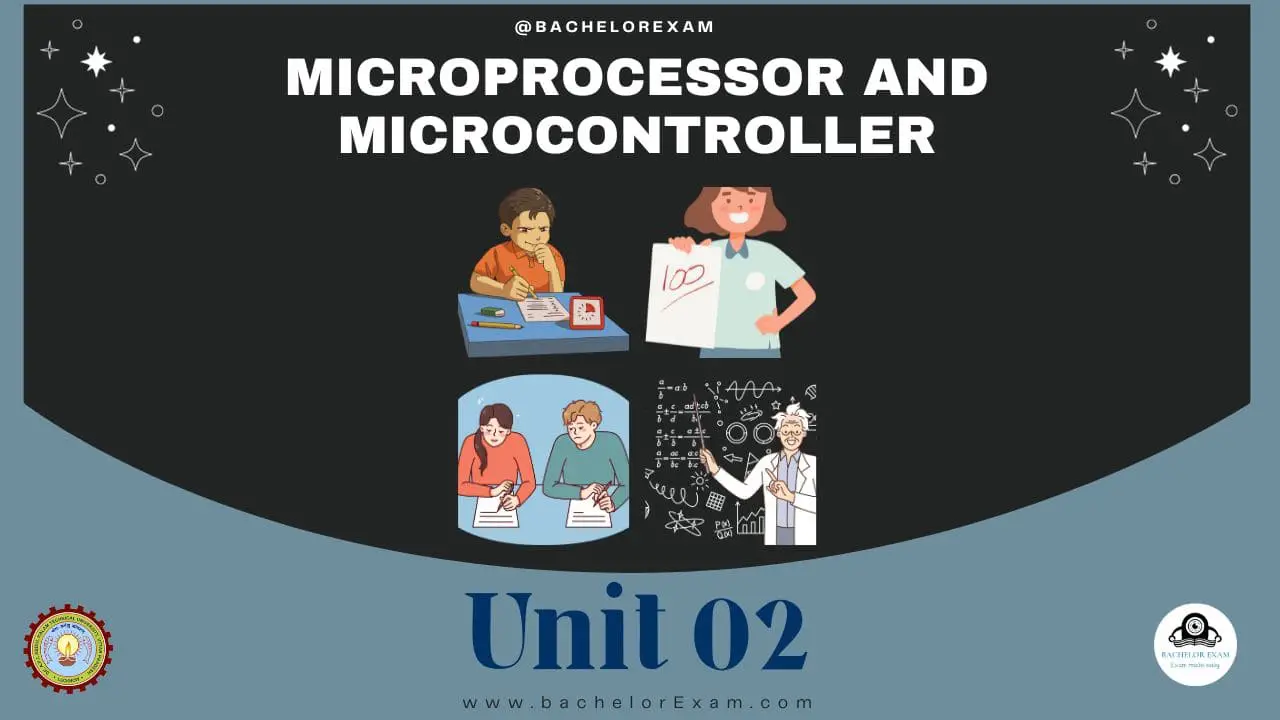Table Of Contents
Use the essential, commonly asked questions from Quantum Notes to improve your study for the Aktu Btech Microprocessor and Microcontroller exam. Improve your comprehension today to ace your tests! Unit-2 Basic Programming Concepts
Dudes 🤔.. You want more useful details regarding this subject. Please keep in mind this as well. Important Questions For Microprocessor and Microcontroller: * Aktu Quantum * B.tech-Syllabus * Circulars * B.tech AKTU RESULT * Btech 3rd Year * Aktu Solved Question Paper
Q1. Draw a flow chart to determine maximum of three numbers.
Ans.
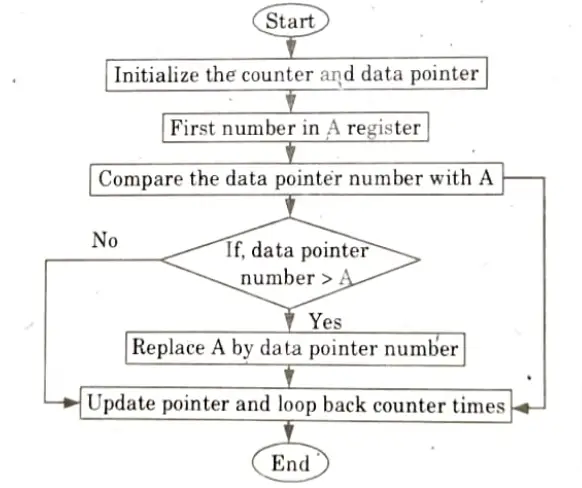


Q2. Discuss logical operation in detail.
Ans. Logical instruction: These are the instructions used to perform the logical operation like AND, OR, XOR etc.
- 1. ANA (Logical AND with accumulator): The contents of accumulator are logically ANDed with the contents of register or memory location and result is stored in the accumulator.
- Format: ANA R/M
- 2. ANI (AND immediate with accumulator): This instruction ANDed the contents of accumulator with specified 8-bit data and result is placed in accumulator.
- Format: ANI 8-bit data
- 3. XRA (Exclusive OR with accumulator): The contents of specifñed register/memory location are Exclusive ORed with contents of the accumulator and result is placed in accumulator.
- Format: XRA R/M
- 4. XRI (Exclusive OR immediate with accumulator): The 8-bit data are exclusive ORed with contents of accumulator and result is placed in the accumulator.
- Format: XRI 8-bit data
- 5. ORA (Logically OR with accumulator): This instruction logically ORed the contents of accumulator with contents of register on memory location.
- Format: ORA R/M
- 6. ORI (Logically OR immediate): The contents of accumulator are logically ORed with the 8-bit data in operand and the result is stored in accumulator.
- Format: ORI 8-bit data
Q3. Explain the various steps involved in writing the assembly language programs.
Ans.
- 1. A program is a set of instructions put in a precise order to carry out a certain task.
- 2. It tells the microprocessor what it has to do.
- 3. Programming is the process of creating the set of instructions that tell the microprocessor what to do.
Steps involved in programming:
- i. Specifying the problem: The first step in programming is to identify the work that needs to be completed. This process is known as problem specification. Programming cannot start if the programmer is unclear on what has to be done.
- ii. Designing the problem-solution: The exact, step-by-step procedure to be followed is defined during this process and documented.
- iii. Coding:
- 1. The software can be put into use once it has been specified and created. Coding the software is the first step of implementation. Coding a programme entails communicating to the processor the precise, step-by-step instructions in its language.
- 2. There are a set of instructions for each processor. To develop the programme, the programmer must select the proper instructions from the instruction set.
- iv. Debugging: Debugging the code comes next once the programme or a portion of the programme has been written. Testing the code to determine if it completes the requested task is the process of debugging. The debugging process aids in identifying and fixing faults when a software is not functioning properly.
Q4. Explain the various looping techniques used in programming.
Ans.
- 1. The programming method of “looping” tells the CPU to repeat operations.
- 2. A loop is created by telling the microprocessor to carry out the task in a different order and then repeat it.
- 3. This process is done using jump instruction. Loops are classified into two groups:
- i. Continuous loop: These loops are created using instructions for unconditional jumps. Unless the system is reset, a programme containing this kind of loop does not terminate.
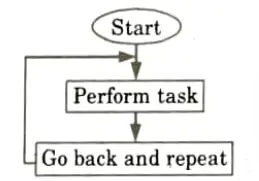


- ii. Conditional loop: Conditional jump instructions are used to configure these loops. These instructions examine flags (carry, zero, etc.), and if the conditions are met, repeat the stated task. Counting and indexing are frequently used in these loops.
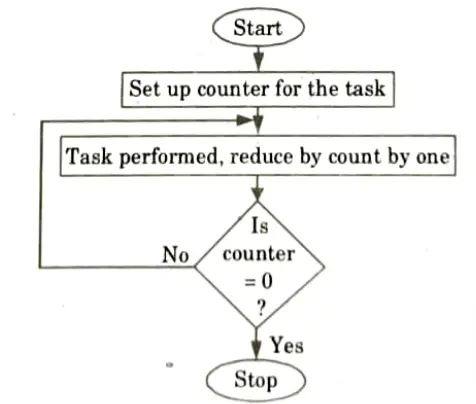


- 4. Counter: A counter is a way to apply a loop of conditions. When a task needs to be repeated a set number of times on the microprocessor, a counter and conditional loop are used to complete the task. The task is repeated using a conditional loop, and the number of times it needs to be completed is counted using the counter.
- 5. Conditional loop using counting and indexing:
- i. Indexing refers to referencing or pointing to items using sequential numbers.
- ii. For instance, books are sorted and organized in libraries using numbers to determine their placement and order. This process of storing data bytes in memory locations and referring to them by their memory locations is known as indexing.
Q5. Sixteen bytes of data are stored in memory location at 205F H. Write a programme transfer the entire block of data to new memory locations starting at 2070 H.
Ans.
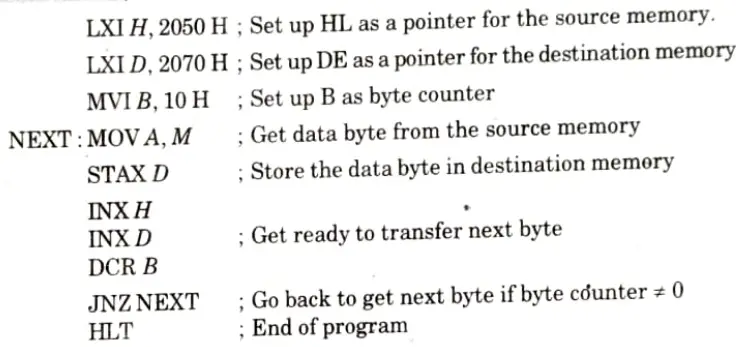


Q6. Write a note on debugging techniques.
Ans. The debugging techniques are used to check the errors in a counter program. Various errors which may occur in the programs are:
- 1. Errors in counting T-states in a delay loop. Most of the times, first instruction to load a delay register is included in loop by mistake.
- 2. Errors in calculating how many times a loop is repeated.
- 3. Failure to convert a delay count from a decimal number into its equivalent hexadecimal number.
- 4. Error in converting a delay count from a decimal number to its hexadecimal equivalent or vice-versa.
- 5. Specifying a wrong jump location.
- 6. Failure to set a flag, especially with 16-bit decrement / increment instruction.
- 7. Failure to display either the first or last count.
- 8. Failure to provide a delay between the last and the last-but-one count.



Important Question with solutions | AKTU Quantums | Syllabus | Short Questions
Microprocessor and Microcontroller Btech Quantum PDF, Syllabus, Important Questions
| Label | Link |
|---|---|
| Subject Syllabus | Syllabus |
| Short Questions | Short-question |
| Question paper – 2021-22 | 2021-22 |
Microprocessor and Microcontroller Quantum PDF | AKTU Quantum PDF:
| Quantum Series | Links |
| Quantum -2022-23 | 2022-23 |
AKTU Important Links | Btech Syllabus
| Link Name | Links |
|---|---|
| Btech AKTU Circulars | Links |
| Btech AKTU Syllabus | Links |
| Btech AKTU Student Dashboard | Student Dashboard |
| AKTU RESULT (One VIew) | Student Result |
